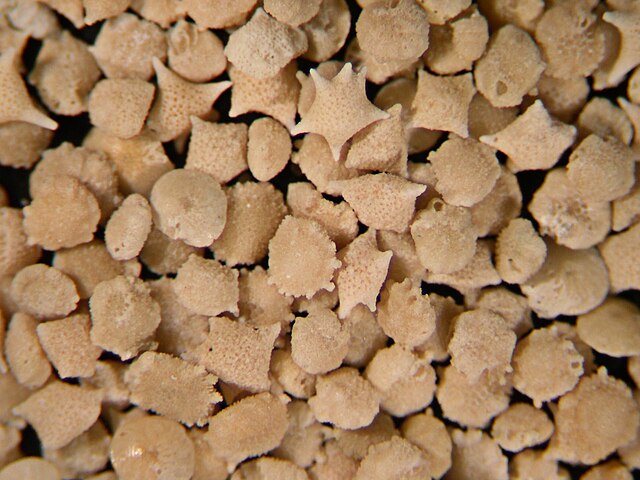Isola corallina
Da Wikipedia, l'enciclopedia libera
L'isola corallina, detta anche cay (in inglese cay, in spagnolo cayo, in francese caye), è una piccola isola sabbiosa formata sulla superficie della barriera corallina. Isole con queste caratteristiche sono situate sia nell'oceano Atlantico che in quello Pacifico e Indiano nelle zone con clima tropicale. Molte di queste isole sono abitate e l'ecosistema locale consente il sostentamento della popolazione.

Formazione e composizione

L'isola si forma quando le correnti oceaniche rilasciano i sedimenti che trasportano incontrando un'altra corrente. Gradualmente i sedimenti si accumulano sulla barriera corallina oppure su uno sperone di roccia che affiora dal mare.
Questi sedimenti sono quasi esclusivamente di origine biologica (scheletri di animali e resti di piante) e sono composti prevalentemente da carbonato di calcio ((CaCO3), aragonite, calcite e magnesio prodotti da specie vegetali (alghe coralline, particolarmente dal genere Halimeda) e animali, quali coralli, molluschi e Foraminifera. Per piccole quantità di silicato, contribuiscono inoltre le spugne.
Nel corso del tempo si può sviluppare la vegetazione grazie anche al guano di uccelli.
Sviluppo e stabilità
Cause fisiche, chimiche e biologiche determinano lo sviluppo o l'erosione delle isole coralline. Principalmente queste sono: l'accumulo di sabbia lungo la barriera corallina, cambiamenti delle correnti marine, maree e fenomeni meteorologici. Questi ultimi sono responsabili di significativi cambiamenti come ha dimostrato El Niño e altri cicloni tropicali.
Bibliografia
- Chave, K. (1964) "Skeletal Durability and Preservation". In: J. Imbrie and N. Newell (Eds.), Approaches to Palaeoecology. John Wiley and Sons Inc., Sydney.
- Folk, R. and Robles, P. (1964) "Carbonate sands of Isla Perez, Alacran Reef Complex, Yucatan. Journal of Geology 72(3): 255-292.
- Gourlay, M.R. (1988) "Coral cays: products of wave action and geological processes in a biogenic environment". Proceedings of the 6th International Coral Reef Symposium, Townsville, Australia 497-502.
- Harney, J.N. and Fletcher, C.H. (2003) "A budget of carbonate framework and sediment production, Kailua Bay, Oahu, Hawaii". ;;Journal of Sedimentary Research;; 73(6): 856-868.
- Hart, D.E. (2003) "The importance of Sea-Level in an Inter-Tidal Reef Platform System, Warraber Island, Torres Strait". Proceedings of the 22nd Biennial New Zealand Geographical Society Conference, Auckland, 2003. pp 77–81.
- Hart, D.E. and Kench, P.S. (2007) "Carbonate production of an emergent reef platform, Warraber Island, Torres Strait, Australia". Coral Reefs 26: 53–68.
- Hopley, D. (1981) "Sediment movement around a coral cay, Great Barrier Reef, Australia". Pacific Geology 15: 17-36.
- Hopley, D. (1982) The Geomorphology of the Great Barrier Reef - Quaternary Development of Coral Reefs. Wiley-Interscience Publication, John Wiley and Sons Ltd., New York.
- Kench, P.S. and Cowell, P. (2002) "Erosion of low-lying reef islands". TIEMPO 46: 6-12.
- McLean, R. and Stoddart, D. (1978) "Reef island sediments of the northern Great Barrier Reef". Philosophical Transactions Royal Society London A291: 101-118.
- Scoffin, T.P. (1987) Introduction to Carbonate Sediments and Rocks. Blackwell, Glasgow.
- Scoffin, T.P. (1993) "The geological effects of hurricanes on coral reefs and the interpretation of storm deposits". Coral Reefs 12: 203-221.
- Woodroffe, C.D. (2003) Coasts: Form, Process and Evolution. Cambridge University Press, Cambridge.
- Woodroffe, C.D., Kennedy, D.M., Hopley, D., Rasmussen, C.E. and Smithers, S.G. (2000) "Holocene reef growth in Torres Strait", Marine Geology 170: 331-346.
- Woodroffe, C.D., Samosorn, B., Hua, Q. and Hart, D. E. (2007) "Incremental accretion of a sandy reef island over the past 3000 years indicated by component-specific radiocarbon dating", Geophysical Research Letters., 34, L03602, doi:10.1029/2006GL028875.
- Yamano, H., Miyajima, T. and Koike, I. (2000) "Importance of foraminifera for the formation and maintenance of a coral sand cay: Green Island, the Great Barrier Reef, Australia". Coral Reefs 19: 51-58.
Voci correlate
Collegamenti esterni
- (EN) cay, su Enciclopedia Britannica, Encyclopædia Britannica, Inc.
Wikiwand - on
Seamless Wikipedia browsing. On steroids.
